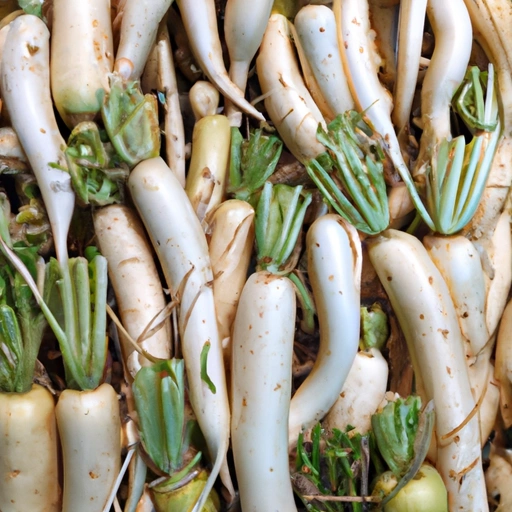Korean Radish
Description

Korean radish, known as 'mu' in Korean, is a type of radish with a firm crunchy texture and a slightly sweet and peppery flavor. Unlike its smaller, rounder European counterpart, the Korean radish is larger and typically oval or elongated in shape. Its skin can range from pale green to white, and its flesh is dense and white. This root vegetable is a staple in Korean cuisine and is revered for its versatility in various dishes.
Common uses
Korean radish is most commonly used in the preparation of kimchi, where it is pickled and fermented. It is also served fresh, cooked, or as a garnish in a variety of Korean dishes.
Nutritional value
Calories
Low in calories, a 100-gram serving of Korean radish contains approximately 18 kcal (75 kJ).
Protein
The same serving size provides about 0.6 grams of protein.
Fat
Korean radish contains a negligible amount of fat, with less than 0.1 grams per 100-gram serving.
Carbohydrates
It is a good source of carbohydrates, with about 3.9 grams per 100-gram serving.
Vitamins
This radish is a source of vitamin C, providing about 22 milligrams per 100-gram serving (approximately 37% of the daily value based on a 2,000-calorie diet).
Minerals
It contains essential minerals such as potassium, with around 233 milligrams per 100-gram serving, and calcium, with about 27 milligrams in the same serving size.
Health benefits
The nutritional profile of Korean radish makes it beneficial for digestive health, immune support, and hydration. The fiber content helps promote a healthy gut, while the vitamin C boosts the immune system.
Potential risks
For individuals with thyroid conditions, excessive consumption of Korean radish may impact thyroid function due to the presence of goitrogens. As with any food, moderation is key.
Common recipes
Popular recipes include kkakdugi (cubed radish kimchi), mu namul (seasoned and sautéed radish), and mu guk (radish soup).
Cooking methods
Korean radish can be enjoyed raw, pickled, fermented, sautéed, simmered, or boiled.
Pairing with other ingredients
It pairs well with meats like beef and pork, and complements spicy and savory flavors found in Korean cuisine.
Summary
Korean radish is a uniquely flavorful and crunchy vegetable that is a cornerstone of Korean cooking. With its health benefits and wide range of uses, it is a great addition to various dishes, offering both nutritional value and culinary diversity.